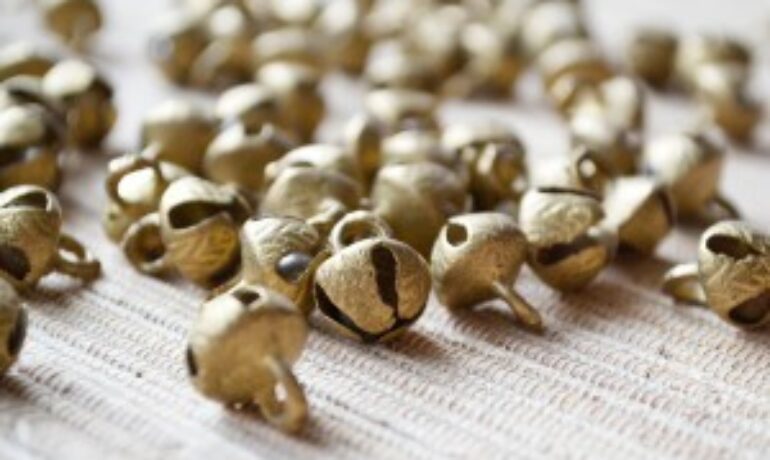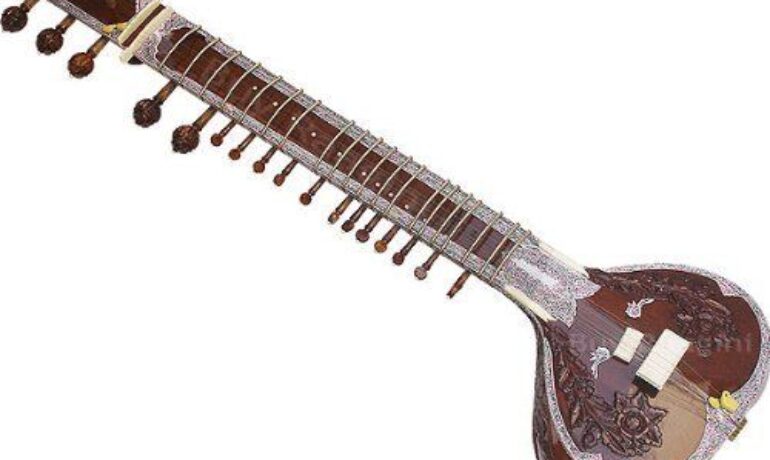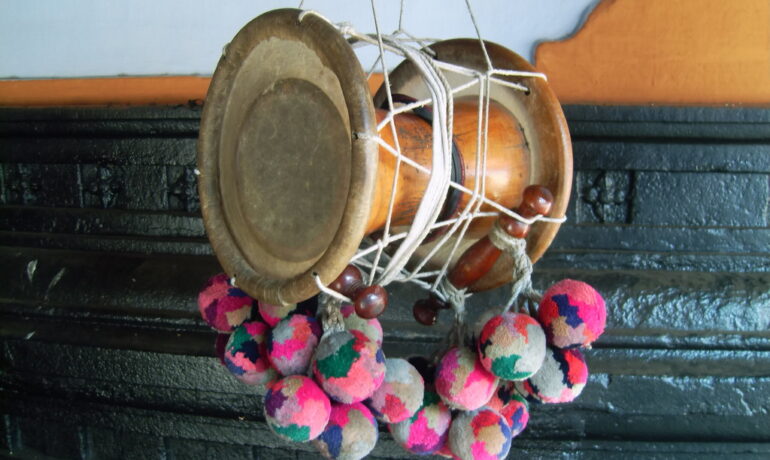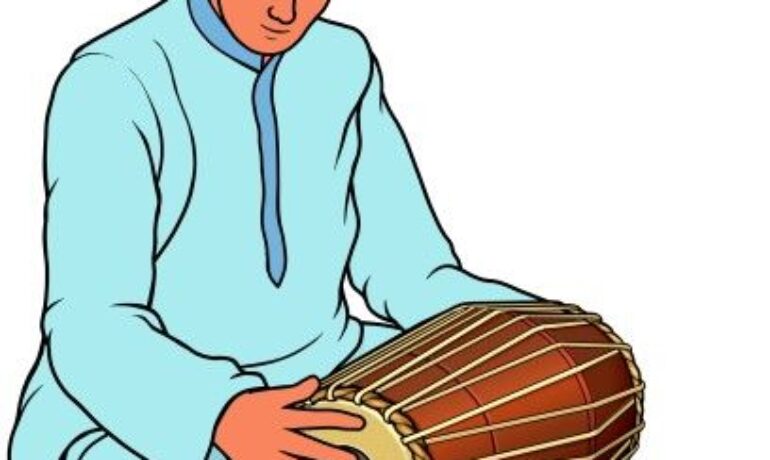The sound of the Shankha plays an important role when something significant begins in Sanatana Dharma (Hindu Dharma) and Buddhism. Shankha represents luster, brilliance, purity, and auspicious start. It is viewed as a devout article and is utilized in all religious ceremonies. It is widely believed that the first use of the Shankha took place […]
Read MoreWoman playing the Dilruba. The dilruba is spelled as dilrupa.Iit emerged from India. It is a bowed instrument larger than an esraj. It has a great significance in Sikh history. The word dilruba is derived from a Hindi word that means “that which ravishes or steals the heart. History It was invested by the 10th […]
Read MoreBasuri is a musical instrument from the Indian subcontinent. It is a flute that is blown sideways the bamboo stem is used to produce this aerophone. it is used to accompany Hindustani classical music and is usually referred to as Nadi and Tunave in the Vedic texts of Rigveda. In the Natya Shastra in Sanskrit, […]
Read MoreE- Tanpura is a substitute for Tanpura performers. this can generate the sound of Tanpura when Tanpura performers are not available. It has a different pitch to match the pitch of the performers. It replicates the Tanpura, an Indian stringed instrument. It is also called an electronic tambura, or a shruti box, etc. Function The […]
Read MoreKonnakol is the art of reciting rhythmic language through Carnatic percussion syllables. it can be performed as a solo or group accompaniment to vocal or instrumental recital performances. for many years it has been the most appealing art which attracted musicians and common men. it is even used as an accompaniment in Classical music concerts […]
Read MoreHarmonium is a Reed Organ or a keyboard instrument that is operated by foot and produces sound through a pressure-equalizing air reservoir. The size of the reed decides the pitch but there are no pipes. The sets of reeds produce tones of various pitches. The air reservoir equalizes pressure and causes the metal reeds to […]
Read MoreMorsing is similar to Jew’s harp especially played in Rajasthan, Sindh, and Pakistan and Carnatic music of South India. It is categorized into lamellophones consisting of a metal ring in the shape of a horseshoe as two parallel forks forming the frame. The metal tongue is made to vibrate this is bent and called the […]
Read MoreShankha means a conch shell that has religious and ritual importance in the Hindu culture. the shell of a large sea snail which is a large predator which is found in the Indian ocean. The Shanka is considered as a sacred emblem of God Vishnu according to Hindu mythology. in the past it was used […]
Read MoreThe Rocking Instrument- Sursringar Another form of Seniya Rabab is Sursringar. There are a few limitations to the rabab. The been has an advantage over rabab as the gut strings and skin parchment which are upon the resonator in the rabab slowed down the Alapchari. The sound of the rabab deteriorates due to the […]
Read MoreWhat is Esraj? The Indian bowed instrument also called ‘esraj’, is well known with the name ‘Tar Shehnai’. The metal horn that is attached to its soundboard amplifies the sound. Sometimes, the horn of a phonograph is used in the instrument. The sounds produced by a violin and Shehnai (instrument of India) are similar to […]
Read MoreIn order to to complement the the rhythm of the dance, the dancers wear ghungroo which is made of several metal bells that are strung together. The ghungroo are used in many folk dances and even in bhajans and abhang to give the additional rhythmic touch. The old ghungroos were made by arranging the metallic […]
Read MoreGhatam is an instrument in India that is unlike tabla and mridangam as it doesn’t have a covering of a membrane over its mouth. It produces various metallic sounds and comes in different sizes which give rise to give different pitches. The Ghatam should be held by the player with the mouth pressed against the […]
Read MoreSwaram means note and Mandal means group it means that the Swarmandal indicates a large number of notes which can be produced by it. It is used in Hindustani vocal music. The instrument is tuned to produce a particular Raaga and to create a sound space during a break for taking a breath. It is […]
Read MoreAn instrument that is used in classical and folk music is the nadaswaram which is an instrument made of wood and metal and it can be played by blowing wind. This instrument is accompanied by thavil (a drum). Nada means pleasant sound and Swaram means note. The sound which is produced is considered auspicious and […]
Read MoreKanjira belongs to the family of the tambourine and has emerged from South India. It has been known by different names like: ganjira, khanjiri and khanjari. It produces a unique resonant sound due to the bells or zils which are inside the frame. The frame usually measures 17 to 19 cm in diameter and 6 […]
Read MoreSarangi is a very refined bowed instrument used in North India.IN the mid 17th century it became popular in the folk tradition as a component of vocal music. It is derived from Seh (Persian meaning three) and (Sarangi meaning colored). It is also known to mean a hundred colors which represent its flexible tunability. In […]
Read MoreThe Sitar is a pear-shaped instrument of the lute family. This instrument has a long, wide hollow wooden neck along with front and side tuning pegs and 20 arched movable frets. It is very popular in Pakistan, northern India, and Bangladesh. It has metallic strings and are five in number and has two drone stings […]
Read MoreTanpura is used in Carnatic and Hindustani music which is a drone instrument. Adharaswara is the base note which creates an aesthetic ambiance in the concert. Tanpura can make all the seven notes of the gamut. It doesn’t provide specific notes or rhythm; it can only provide a circle of certain pitches that don’t produce […]
Read MoreTo accompany nadaswaram used for Hindu religious music. It is made of jackfruit wood with an animal membrane stretched on either side. The instrument is hung by a strap of cloth from the neck. The fingertips are covered by thumbcaps made up of wheat flour and water. The stick on the left ad fingers on […]
Read MoreUdukkai is an hourglass-shaped instrument used for devotional and folk music in India. If we tighten the lace in the middle it changes the pitch. It is made of wood or brass. It is very good in the market as the features are unmatchable. The udukku is covered with skin surfaces covered on both sides. […]
Read MoreViolin, byname fiddle, bowed stringed musical instrument that evolved during the Renaissance from earlier bowed instruments: the medieval fiddle; its 16th-century Italian offshoot, the lira da braccio; and the rebec. The violin is probably the best known and most widely distributed musical instrument in the world. Like its predecessors but unlike its cousin the viol, the violin has a fretless fingerboard. Its strings are hitched […]
Read MoreMandolin is an eight-stringed instrument and resembles the lute and it first emerged in the 18th century in Italy. It ranges from classical to bluegrass and to jazz it covers all styles of music. It evolved from Mandora in the 16th century. Mandolin first appeared in Naples, Italy in the mid-1700s. It was named as […]
Read MoreSarod is a common string instrument belonging to the lute family in northern India, Pakistan, and Bangladesh. The sarod is about 39 inches and the wooden body has a skin belly. The neck is broad and contains a fretless fingerboard covered in metal. The fingerboard is useful as it accommodates the characteristic sliding pitches. The […]
Read MorePakhawaj is a musical instrument that is modified a little bit in the case of Mridangam, a south Indian instrument. It is similar to Pakhawaj externally but the technique and construction are different. The tone of the instruments is also different from each other because the construction is different. The mridangam has an annular membrane […]
Read MoreThe most popular drum set in North Indian music. Tabla is used in instrumental and vocal music as well as dance. It’s the best percussion instrument throughout India as it is very versatile in all musical styles. Due to the tonal beauty and sophisticated nature, it has reached an unmatched status. Tabla maintains the metric […]
Read MoreDating back to the first millennium B.C, the Veena is one of the oldest instruments. The sculptures from the 2nd century B.C depict veena played. The Carnatic music highlights the Saraswati veena and the Rudra veena is played the most in Hindustani music. Seven strings are strung over the frets which are 24 in number. […]
Read More



















